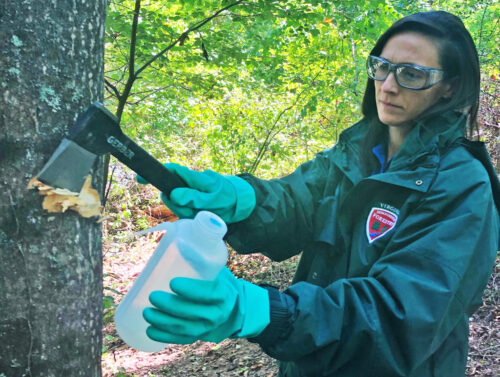
What is an Invasive Plant?
Invasive plants pose a serious risk to ecosystems in Virginia. These plants are non-native, have been introduced to new ecosystems by humans, and cause damage to the economy, the environment or to human health. They are costly to control, reduce productivity within forests, can grow faster than native species, and spread quickly. Invasive plants can be trees, shrubs, grasses, or other herbaceous species. There are many species of invasive plants that threaten Virginia’s forests and landscapes, as well as tools to help identify and combat these species.
Identification of Invasive Plants in Virginia
Some examples of common invasive species found in Virginia are tree-of-heaven, autumn olive, Callery pear, Japanese honeysuckle, Asiatic bittersweet, kudzu, Japanese stiltgrass, multiflora rose and multiple species of privet. Also, be on the lookout for emerging species of concern such as wavyleaf grass, incised fumewort, fountain grass and leatherleaf mahonia.
| Image | Title | ID | Description | View |
|---|---|---|---|---|
| Invasive Plants – Help Stop the Spread | P00216 | Brochure educates citizens about invasive plants, including what makes an plant invasive, the problems they cause, characteristics, and how to stop the spread of invasive plants. Printed copies available. | View | |
| Virginia Invasive Plant Species List | The Virginia Department of Conservation and Recreation maintains the invasive plant species list. | View | ||
| Virginia’s Least Wanted – Invasive Plants | PST004 | Poster helps identify invasive plants, which threaten our forest ecosystems. Designed for 24 in. x 36 in. poster. Target audience: Youth – elementary age. | View |
Control of Invasive Plants in Virginia
The first action everyone can take to help with controlling invasive plants in Virginia is to avoid introducing new invasive plants; always plant native plant species. History has taught us that the permanent eradication of a weed species from a geographic region is not a realistic goal. However, there are treatment and control options to reduce or eliminate invasive plants in a limited area.
| Image | Title | ID | Description | View |
|---|---|---|---|---|
| A Management Guide for Invasive Plants in Southern Forests | SRS-131 | Invasions of nonnative plants into forests of the Southern United States continue to spread and include new species, increasingly eroding forest productivity, hindering forest use and management activities, and degrading diversity and wildlife habitat. This book provides the latest information on how to organize and enact prevention programs, build strategies, implement integrated procedures for management, and proceed towards site rehabilitation and restoration. Effective control prescriptions are provided for 56 nonnative plants and groups currently invading the forests of the 13 Southern States. A companion book, “A Field Guide for the Identification of Invasive Plants in Southern Forests,” (Miller and others 2010) includes information and images for accurate identification of these invasive plants. | View | |
 | Ailanthus Control Methods – Removing Tree-of-Heaven | FT0055 | Forestry topic information sheet provides information about the invasive species Ailanthus and possible methods for removing or controlling Ailanthus, including manual as well as chemical methods such as foliar spray, stem injection or basal spray. | View |
 | Callery Pear Control Best Management Practices – Controlling the Invasive Pyrus Calleryana | FT0067 | Forestry topic information sheet provides best management practices for controlling the invasive Callery pear (Pyrus calleryana). | View |
 | Control and Utilization of Tree-of-Heaven: A Guide for Virginia Landowners | P00144 | Publication provides landowners comprehensive insight to this invasive species, including biology and life cycle, control and elimination methods, utilization of ailanthus, and other resources available. Printed copies available. | View |
 | Don’t Move Firewood, Virginia | As the days turn cooler and shorter, many Virginians are using firewood to keep warm and spend quality time with friends and family. While seemingly harmless, moving firewood can enable the easy movement of destructive forest and agricultural pests. When firewood is moved from one area to another, the invasive emerald ash borer, spongy moth, Asian longhorned beetle, and spotted lanternfly often “hitchhike” to destroy crops, infect more trees and sometimes even entire forests. | View | |
| Methods for Treating Invasive Plants with Chemicals | In this video, we explain and demonstrate four common methods for treating invasive plants with chemicals. Remember to always wear the correct PPE and to read and follow the instructions on a chemical’s label for safe and effective applications. | View | ||
 | No. 145 Triclopyr Ester for Controlling Tree-of-Heaven | RR-145 | Report provides results from a series of four studies of tree-of-heaven control using triclopyr ester applied at different times during the year by basal spray or cut stump application methods. A mixture of 25% triclopyr ester herbicide in an oil-based carrier achieved excellent tree-of-heaven control for trees up to 16 inches in diameter. | View |
 | Non-Native Invasive Plant Species Control Treatments – Timing Methods and Herbicide Rates | FT0031 | Forestry topic information sheet provides information about possible control treatments for some of Virginia’s most common non-native invasive plant species. | View |
| Virginia’s Least Wanted: Callery Pear | Callery pear is a rapid-growing tree that poses a major threat to Virginia’s plant biodiversity. In this video, we’ll discuss how to identify and remove Callery pear trees. | View |
Contact Us
For more information or questions, e-mail us or use our contact form.
